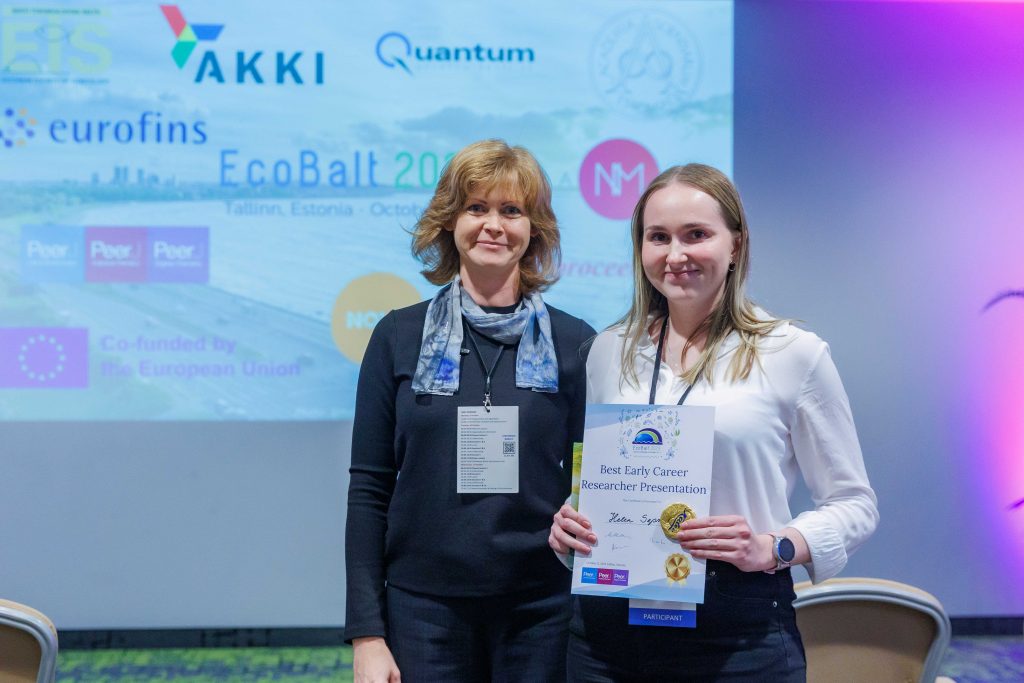The 23rd biennial conference EcoBalt 2023 (https://ecobalt2023.kbfi.ee/) took place in Tallinn, Estonia, on October 9-11. It continued the tradition of international EcoBalt conferences in bringing together scientists, students, regulators, and industry representatives from the Baltic States and nearby regions. During two and a half days of the onsite event, close to 200 participants from 21 countries had a chance to listen to 59 talks from experts in their fields as well as from early career researchers. In addition, 45 posters were presented during the conference. The interdisciplinary program of EcoBalt 2023 offered networking opportunities to environmental scientists, ecologists, analytical and organic chemists, material scientists, toxicologists, and risk assessors. According to the participants, EcoBalt 2023 was a huge success and in two years EcoBalt will return to Vilnius, Lithuania.
Monika Mortimer, Chair of EcoBalt 2023 Organizing Committee.
Vladyslav Dovhalyuk PhD candidate at Uppsala University, Sweden.
 Can you tell us a bit about yourself and your research interests?
Can you tell us a bit about yourself and your research interests?
I am in the third year of pursuing my PhD in analytical chemistry in the laboratory of Daniel Globisch. My main research interest is resolving untargeted metabolomics with the use of liquid chromatography in combination with high-resolution tandem mass spectrometry (LC-MS/MS), and the application of chemical biology tools for biomarker discovery linking gut microbiota metabolism and pathophysiology of pancreatic cancer.
What first interested you in this field of research?
The most interesting aspect of metabolomics to me is a linkage of very powerful analytical techniques to discover changes and biology to understand and interpret the findings.
Can you briefly explain the research you presented at EcoBalt 2023?
My poster provides an overview of our recent metabolomics studies of stool samples of patients with a high risk of developing pancreatic cancer with the use of a Chemoselective probe. We were able to increase the sensitivity and selectivity of our analysis and identify a number of metabolic thiols previously not reported in this specimen.
What are your next steps?
We are working on Chemoselective probes that are selective towards other functional groups and helps us to better understand the respective metabolome. Metagenomics analysis will provide us with valuable information on bacterial composition, which will help us to better understand microbiota metabolome. Analysis of samples from different high-risk groups and types of pancreatic cancer will broaden our understanding on how metabolic processes are reflecting changes in the organism.
Helen Sepman PhD candidate at Stockholm University, Sweden.
 Can you tell us a bit about yourself and your research interests?
Can you tell us a bit about yourself and your research interests?
As novel chemicals are continuously introduced and used in our daily lives, many of them find their way into the environment, leading to humans and wildlife being exposed to complex mixtures of chemicals. While LC-HRMS is a valuable tool to showcase the chemical complexity of environmental samples, it does not provide a full picture of all chemicals present. Typically, the risk assessment of a single chemical can only take place after its structure has been identified, either experimentally or with in silico tools. Consequently, all detected chemicals that remain unidentified (known unknowns) are overlooked in risk assessment.
In my PhD project, I am investigating the possibility of using experimental data from non-targeted analysis to predict mixture toxicity for all detected chemicals in the sample. We use fragmentation spectra of the known unknown chemicals to estimate their toxicity and ionization efficiency and therefore provide a wider picture of the whole sample. This approach allows us to estimate if any of these chemicals may be present in excessive concentrations and need to be prioritized for identification. Personally, I find this research field fascinating as it is interdisciplinary and makes use of data science methodologies in environmental research.
To achieve this, our research group has developed two machine learning tools: MS2Tox which predicts fish acute toxicity (LC50) and MS2Quant which predicts ionization efficiency in electrospray ionization. Both of these tools require a fragmentation spectrum of a chemical which is processed using SIRIUS+CSI:FingerID software that predicts the probabilities of presence or absence of different chemical substructures, and these predictions are then fed into our models. These models have been tested and validated separately, and as the next step we are exploring the combined application of MS2Tox and MS2Quant for risk estimation and chemical prioritization.
Can you briefly explain the research you presented at EcoBalt 2023?
During EcoBalt23, I presented the preliminary results of applying these models on wastewater samples. In addition to calculating priority scores for chemicals with fragmentation spectra we also investigated data acquisition approaches for obtaining high-quality spectra for high-risk chemicals. Our preliminary results indicate that all tested approaches are complementary and trigger slightly different high-risk chemicals.
What are your next steps?
It is important to emphasize that the development of tools for quick and high throughput risk estimation for unidentified chemicals is in its baby steps. Considering that the number of chemicals used in training the models is orders of magnitude smaller than the entire chemical space (1000× in modeling vs 100,000,000× in PubChem) we are committed to expanding the dataset for training and validating our models. The ultimate goal of this project is to streamline these tools into a user-friendly workflow, making them easily accessible for implementation in environmental sample monitoring.

